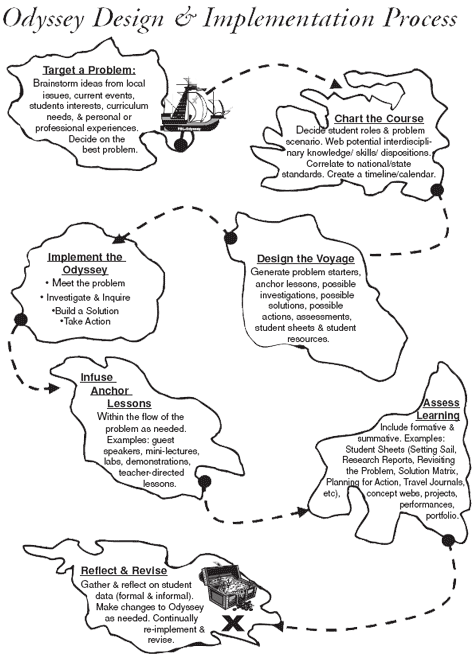Get Involved!
The EXCITE Odyssey Design and Implementation Process
For those teachers who would like to develop a problem-based Odyssey on their own, there are a number of resources on this website to help you. First, be sure that you are comfortable with the EHS System and the PBL Design Model. Then, review the Odyssey Design & Implementation Process described below.

Developing an Odyssey is a lot like embarking on a voyage. You might have an idea of your destination, but the exact route and potential obstacles are unknown. Working with other teachers in various disciplines during the Odyssey Design and Implementation Process, keeps you on course and ensures that your journey is comprehensive and relevant. Keep in mind that you can also use this model individually to create a meaningful unit. Use the model above and the description below to help guide you. For additional resources, such as developed student worksheets, assessment rubrics, or sample lesson plans, or for more information, please visit our resources page or contact our office.
Targeting the Problem –
- Brainstorm local issues, current events, student interests, curriculum needs and personal or professional experiences.
- Critique possible issues to find models that spark student interest and provide strong relevance to the educational standards.
Charting the Course –
- Decide the roles and responsibilities that the students will undertake.
- Develop a scenario or problem and create concept and student experience webs that relate to standards in multiple fields of study.
- Create a timeline or calendar that designates time estimates to each of the phases of the PBL Odyssey model (Meet the Problem, Investigate and Inquire, Build Solutions, and Take Action).
- This timeline should help you streamline your brainstorm/web to develop a more manageable, realistic plan.
Design the Voyage –
- Develop problem starters that introduce the problem by describing the central ideas, as well as the expected student roles and responsibilities (these should be “ill-structured,” concrete, authentic, engaging and likely to lead to many appropriate outcomes).
- Plan anchor lessons. Anchor lessons are more teacher–directed experiences used to provide students with knowledge, skills and dispositions needed for success. Investigations and inquiries are
- “Pre-think” possible student research questions, investigations/inquiries, solutions, and actions. These items are student-centered and student-driven. Be prepared for scenarios that students are likely to create.
- Create student assessment pieces, student worksheets and student resources.
Implement the Odyssey –
- Apply the Odyssey in your classroom (as with any maiden voyage, there might be some unanticipated problems or obstacles and teachers should recognize that experienced difficulties provide valuable information for needed revisions).
- Move through all four steps, trying to spend equal time on each -- Meet the Problem, Investigate and Inquire, Build Solutions, and Take Action
Assess Learning –
- Evaluate student activities through a variety of methods, such as portfolios, oral presentations, student worksheets, and a reflective travel log.
- Contact the EXCITE office for student worksheets, evaluation tools, and rubrics.
Reflect and Revise –
- Use the student assessment information and other faculty viewpoints, as well as mental and written notes to modify and improve the Odyssey.
- Implement the Odyssey the following year.
- Treat your Odyssey as a living document – it is intended to grow and change with time.
